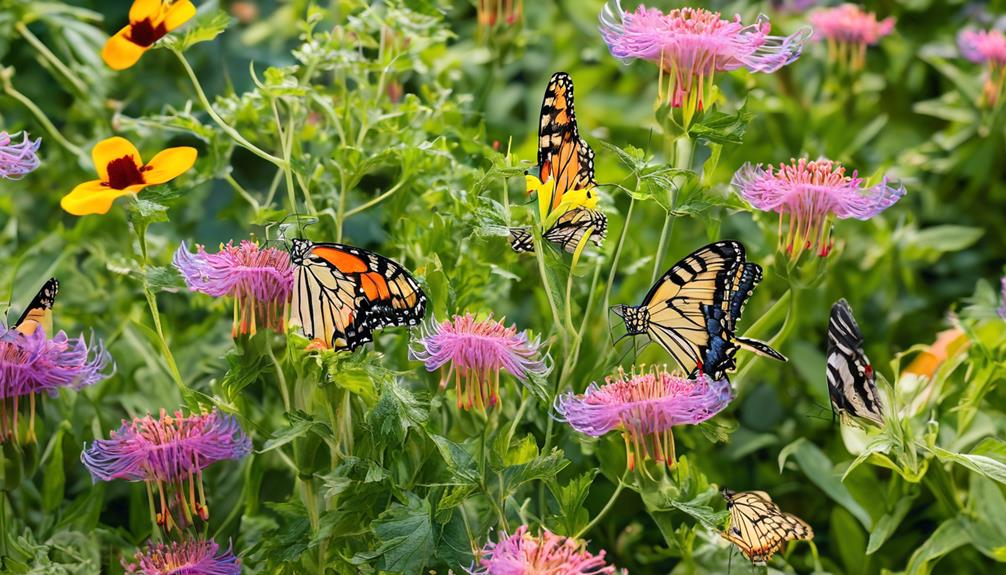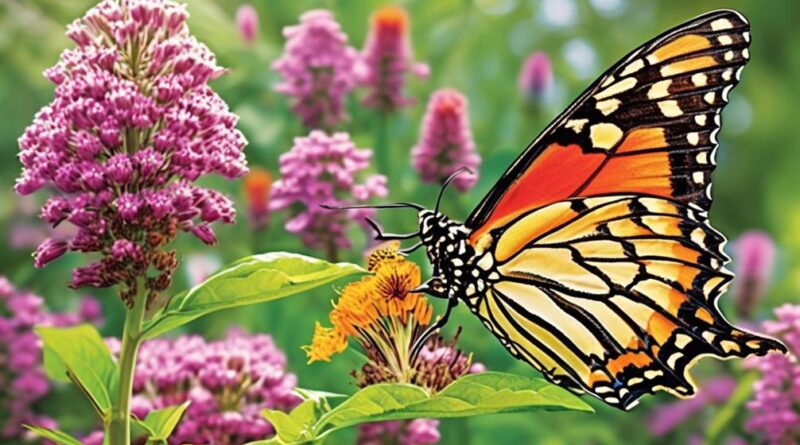Creating Butterfly-Friendly Spaces in Your Garden
This post may contain affiliate links which means I may receive a commission for purchases made through links. As an Amazon Associate, I earn from qualifying purchases. Learn more on my Private Policy page.
Creating a butterfly-friendly garden is like crafting a vibrant, living tapestry that flutters and dances with life. As you step into this world of color and movement, you'll find yourself immersed in a natural wonderland, where every corner holds the potential for enchanting encounters.
But how exactly can you transform your garden into a haven for these delicate creatures? Let's explore the subtle art of creating butterfly-friendly spaces, where every thoughtful choice becomes an invitation for these winged visitors to grace your garden with their presence.
Choosing the Right Plants
To create a butterfly-friendly garden, start by selecting a diverse range of nectar-rich plants that bloom at different times throughout the year. When preparing the soil, ensure it's well-draining and rich in organic matter, providing a healthy environment for your chosen plants. Native species are particularly important as they've evolved alongside local butterflies and are well-suited to their needs. By incorporating a variety of native species, you can provide food sources for butterflies throughout their different life stages.
When selecting plants, aim for a seasonal variety to ensure there are nectar-rich blooms available from early spring through late fall. This will attract a diverse range of butterfly species to your garden.
As you begin this process, consider the specific needs of butterflies in your region. Research which native plants are most beneficial for local butterfly populations and incorporate them into your garden. When planning your plant selection, keep in mind that different butterfly species have different preferences, so it's important to provide a variety of options. This includes plants with different flower shapes and colors, as well as those that bloom at different times. By doing so, you can create a haven for butterflies throughout the changing seasons.
Providing Water Sources
Consider incorporating shallow dishes or puddling areas in your garden to provide essential water sources for butterflies. Butterflies need water not just for drinking, but also for maintaining their reproductive activities and overall health.
Here are some tips to ensure that your garden provides the necessary water sources for these delicate creatures:
- Butterfly Puddling: Create a puddling area by filling a shallow depression with sand, soil, and a small amount of water. Butterflies are attracted to minerals found in the soil, which they extract by sipping water from these damp patches. You can enhance the appeal of the puddling area by adding a few flat stones for the butterflies to perch on while they drink.
- Water Dishes: Place shallow dishes or trays filled with water in sunny spots around your garden. These dishes should have sloping sides or rocks placed inside to provide perches for butterflies to land on while they drink. Ensure that the water is shallow to prevent butterflies from drowning.
Adding Butterfly-Friendly Features
Enhance your garden's appeal to butterflies by incorporating specific features and elements that cater to their needs and behaviors.
Start by preparing the soil in your garden. Butterflies are attracted to moist, nutrient-rich soil, so ensure that your garden soil is well-draining and amend it with organic matter such as compost. This will provide butterflies with essential minerals and nutrients.
Additionally, select the right mulch for your garden. Organic mulches like wood chips or straw not only help retain moisture and regulate soil temperature but also provide a suitable environment for butterfly pupae.
When designing your garden layout, consider planting a variety of nectar-rich flowers that bloom at different times of the year. This will attract a diverse range of pollinators, including butterflies. Choose a mix of native flowering plants such as milkweed, coneflowers, and butterfly bush to provide nectar for adult butterflies and host plants for caterpillars. Grouping these plants together can create attractive feeding and resting spots for butterflies while making it easier for you to maintain and observe them.
Incorporate features like flat stones or sand patches in sunny areas for butterflies to bask and warm their wings. These simple additions can make your garden more inviting to butterflies and provide them with the resources they need to thrive.
Creating Sheltered Areas
You can create sheltered areas for butterflies by providing dense vegetation and strategically placing garden structures to offer protection from wind and predators. Building structures such as arbors, trellises, or fences can create sheltered spots where butterflies can rest and seek refuge from harsh weather conditions.
Additionally, planting trees strategically around your garden can also provide natural shelter for butterflies. Choose native trees that provide a canopy for butterflies to seek shelter under during hot days or inclement weather. Position trees in clusters or groups to create pockets of sheltered areas throughout your garden, providing butterflies with multiple places to rest and take cover.
Avoiding Pesticides
With the sheltered areas established, now focus on avoiding pesticides to create a truly butterfly-friendly garden. Pesticides not only harm butterflies but also disrupt the natural balance of your garden. Instead, encourage the presence of natural predators that feed on pest insects. Ladybugs, lacewings, and praying mantises are all beneficial insects that can help control pest populations. By attracting these natural predators to your garden, you can minimize the need for pesticides.
Furthermore, consider using organic alternatives to pesticides. Neem oil, for example, is an effective organic insecticide that targets a wide range of pests while being harmless to butterflies and other beneficial insects. You can also make your own organic insect spray by mixing water with garlic, onion, and cayenne pepper. This natural repellent can deter pests without posing a threat to butterflies.
In addition to natural predators and organic alternatives, practicing good garden hygiene can also reduce the need for pesticides. Removing weeds and debris where pests can hide and lay eggs can help prevent pest infestations. Moreover, cultivating a diverse range of plants can naturally deter pests and attract beneficial insects, creating a balanced ecosystem that reduces the reliance on harmful chemicals.
Maintaining a Sunny Spot
To create a butterfly-friendly garden, ensure that you maintain a sunny spot suitable for their needs. Butterflies thrive in warm, sunny environments, so it's crucial to maximize the sunlight in your garden. Proper maintenance of the sunny spot is essential to create an ideal habitat for these beautiful creatures. Here's how you can achieve this:
- Maximizing Sunlight
- Positioning: Place butterfly-attracting plants in areas that receive direct sunlight for at least 6 hours a day. This will provide the warmth and energy that butterflies require for their activities, such as feeding and mating.
- Pruning: Regularly trim any overhanging branches or foliage that may obstruct the sunlight from reaching the designated butterfly area. This simple task can significantly enhance the overall light exposure in your garden.
Incorporating Host Plants

Incorporate host plants that cater to the specific needs of butterfly species in your garden to provide essential food and shelter for their life cycle. When planning your garden design, prioritize pollinator-friendly landscaping by selecting a variety of host plants that support butterfly conservation. By incorporating host plants, you contribute to ecological gardening and create a welcoming environment for butterflies to thrive.
Consider the specific butterfly species native to your region and their corresponding host plant preferences. For instance, monarch butterflies rely on milkweed as their primary host plant, while swallowtails favor plants such as dill, parsley, and fennel. Research the host plant requirements of the butterflies in your area to ensure that you provide the necessary resources for their life cycle.
When selecting host plants, aim for a diverse range of species to accommodate various butterfly preferences. Incorporating a mix of nectar-rich flowers and host plants can attract a wider array of butterfly species to your garden. Additionally, ensure that the host plants are well-maintained and free from pesticides, creating a safe and healthy habitat for butterflies.
Integrating host plants into your garden not only supports butterfly populations but also adds visual interest and natural beauty to your outdoor space. By prioritizing butterfly-friendly landscaping, you contribute to the conservation of these valuable pollinators while enhancing the ecological balance of your garden.
Ensuring Continuous Blooms
Create an environment with a continuous display of blooms to sustain the attraction and support for butterfly populations in your garden. Ensuring a steady supply of nectar-rich flowers not only enhances the aesthetic appeal of your garden but also plays a crucial role in promoting pollination and attracting wildlife.
Here are some tips to help you achieve this:
- Choose a Variety of Plants: Select a diverse range of flowering plants that bloom at different times throughout the year. This ensures that there are always nectar sources available for butterflies and other pollinators. Examples of such plants include bee balm, coneflowers, and butterfly bush.
- *Early Bloomers:* Incorporate early blooming plants such as crocuses and primroses to provide nectar for butterflies emerging from hibernation in the spring.
- *Late Bloomers:* Include late blooming flowers like sedum and asters to sustain butterflies as they prepare for migration or hibernation in the fall.
Frequently Asked Questions
How Can I Attract Butterflies to My Garden if I Live in a Region With a Shorter Growing Season?
If you live in a region with a shorter growing season, you can still attract butterflies to your garden by planting native flowers, providing a sunny spot, and using rocks for warmth. Consider adding a butterfly feeder to supplement their food sources.
What Are Some Natural Predators of Butterflies That I Should Be Aware of in My Area?
You should be aware of natural predators in your area that can threaten butterfly conservation. Incorporate butterfly gardening practices and climate adaptation strategies to create a safe and welcoming environment for these delicate creatures.
Are There Any Specific Maintenance Tips for Keeping a Butterfly-Friendly Garden in Urban Environments?
In urban environments, maintaining a butterfly-friendly garden involves considering container gardening, rooftop gardens, vertical gardening, and community gardens. These methods help create spaces for butterflies to thrive in the midst of urban development.
Can I Incorporate Butterfly-Friendly Features in a Small Balcony or Patio Garden?
You can definitely incorporate butterfly-friendly features in a small balcony or patio garden. Consider container and vertical gardening to maximize space, and include pollinator-friendly plants and nectar sources to attract butterflies and create a welcoming habitat.
What Are Some Alternative Methods for Pest Control in a Butterfly-Friendly Garden Without Using Pesticides?
You can control pests in a butterfly-friendly garden without using pesticides. Consider companion planting to repel pests, attract beneficial insects, and promote biodiversity. Use organic mulching and crop rotation to naturally manage pests and maintain a healthy garden ecosystem.
Conclusion
So, by choosing the right plants and incorporating host plants, you can create a beautiful and welcoming space for butterflies in your garden.
Providing water sources and creating sheltered areas will also attract butterflies and provide them with the necessary resources.
Avoiding pesticides is important to protect the butterfly population and their habitat.
Maintaining a sunny spot in your garden will ensure that butterflies have access to the warmth and energy they need.
Ensuring continuous blooms throughout the season will provide a consistent food source for butterflies.
With a little effort and attention to detail, you can help support the butterfly population and enjoy the beauty they bring to your outdoor space.
Happy gardening!
